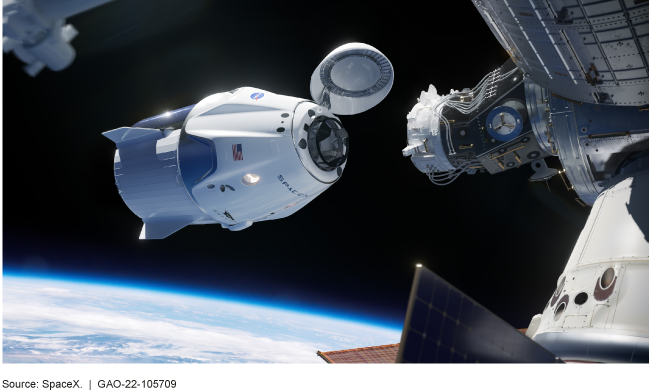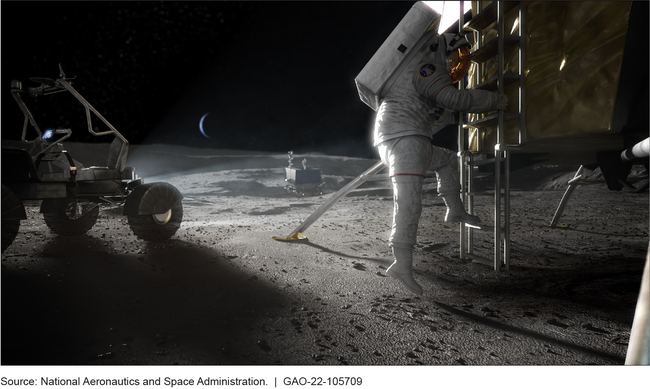NASA: Lessons from Ongoing Major Projects Could Improve Future Outcomes
Fast Facts
Problems like persistent cost increases and delays have earned NASA's acquisition management a spot on our High Risk List. NASA's current portfolio includes projects that leverage work from private companies.
We testified about a few things NASA could do to improve its management, using some examples from our past work.
For example, NASA could:
- Minimize cost increases and delays on its largest projects, which can have ripple effects on the rest of the portfolio
- Improve management of its contractors
- Establish a governance structure for returning astronauts to the moon by, for example, defining more roles, responsibilities, and authorities
Artist depiction of SpaceX’s crew vehicle approaching the International Space Station as part of the Commercial Crew program, a partnership between NASA and industry

Highlights
What GAO Found
The complexity of NASA's major projects means they will always carry inherent risk—but prior GAO work found that management and oversight problems contribute to cost and schedule growth. As NASA works to execute new missions, including those that rely on commercial partners, GAO's past work provides lessons that, if applied, could strengthen NASA's management and improve outcomes of its major projects. For example, NASA could:
Better manage cost and schedule. Increases associated with NASA's most costly and complex missions can have cascading effects on the rest of the portfolio. For example, in April 2013, GAO found that cost growth for the now $10 billion James Webb Space Telescope would have reverberating effects on the NASA acquisition portfolio for years to come.
Minimize risky decisions. NASA leadership has approved decisions that compound technical challenges. For example, in May 2021, GAO found that NASA's planned pace to develop a human landing system (illustrated below) was months faster than other spaceflight programs. The initial proposals also included unproven technologies, which adds technical and schedule risk to the program.
Artist's Rendition of Artemis Lunar Landing Mission

Establish a governance structure. While it has made some progress, NASA has not yet finished establishing its governance structure to oversee and manage its Artemis effort—a series of missions to return astronauts to the lunar surface. In December 2019, GAO recommended that NASA determine a schedule for integration reviews to help ensure that requirements between mission and program levels are reconciled. NASA held the first review in fall 2021. However, in September 2021, NASA announced a reorganization of its human exploration mission directorate. It is too soon to know how these changes will affect NASA's governance of Artemis missions or programs.
Why GAO Did This Study
Acquisition management has been a long-standing challenge at NASA. GAO first designated NASA's acquisition management as a high-risk area in 1990 in view of NASA's history of persistent cost growth and schedule slippage in the majority of its largest systems. While NASA's major projects are complex, specialized, and often groundbreaking, GAO has identified management weaknesses that have exacerbated the inherent technical and engineering risks the projects face.
In 2005, NASA expanded its effort to partner with commercial companies by forming the Commercial Crew and Cargo Program Office. The public-private partnerships established by this program office represented a new way of doing business in the realm of human spaceflight.
This statement reflects GAO's observations on lessons that NASA can apply to its management of its major projects as it seeks to leverage resources between the public and private sector to maximize federal return on program investments.
This statement is based primarily on prior work GAO issued between 2019 and 2021.
Recommendations
In prior work, GAO made recommendations to improve NASA's acquisition of major projects. NASA generally agreed with those recommendations. As of November 2021, NASA has not fully addressed eight priority recommendations related to monitoring program costs and execution, which were detailed most recently in a report to the NASA Administrator in June 2021.
